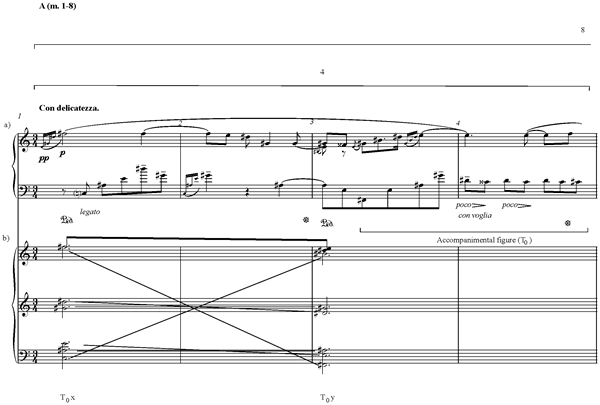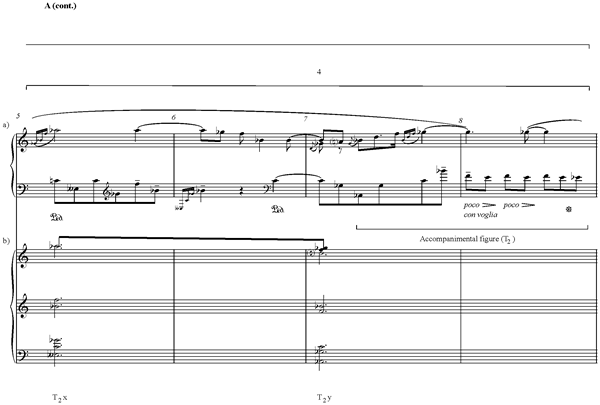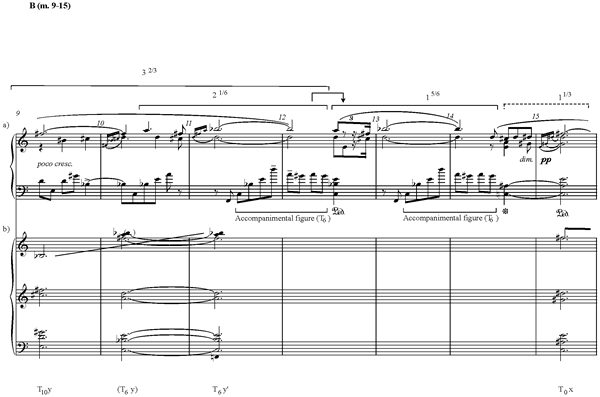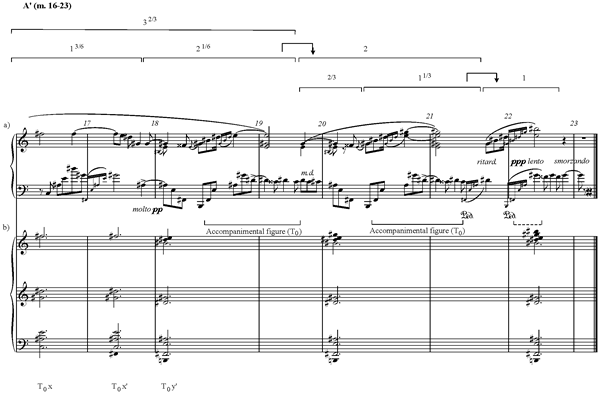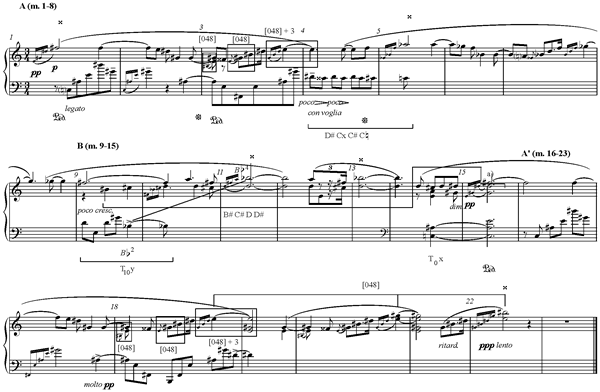Scriabin’s Mature Style and the Coordination of Form, Grouping and Pitch Structures
François de Médicis
[1] Introduction¹
For Scholars interested in matters of style and analysis, Alexander Scriabin’s mature music (from about 1907 onwards) suggests not only a sense of orderly construction, but sheer systematic order. This seems to be no mere analytical chimera, as it is borne out in the composer’s creative idea and compositional process, if we are to believe numerous anecdotes and testimonies. He is frequently reported to have said such things as, “I write in a strict style,” and “There is nothing by accident … I compose according to definite principle.”[2] Boris de Schloezer, who knew the composer personally, confirms this: “in this poet, in this prophet, there lived a refined, almost pedantic formalist who demanded accuracy in all that concerned his creative work. Perfection of form and precision of execution were his characteristic traits.”[3] According to Alexander Goldenveizer, Scriabin intended to disclose his compositional principles to him and Taneyev (the composer’s former counterpoint teacher from the Moscow Conservatory). But after repeated postponements of this discussion, Scriabin ultimately took the secret of his compositional method to his grave.[4]
A number of scholars have attempted to describe the systematic organization of pitch in Scriabin’s music. Their endeavours are rooted in major theoretical trends of the last thirty years (such as set theory, prolongational-linear analysis of post-tonal music, the study of octatonicism, and neo-Riemannian theory). This body of literature engages such fundamental issues as the problem of segmentation in set-theoretical approaches;[5] boundaries between tonality and atonality;[6] the criteria for prolongation in the post-tonal idiom;[7] proto-serialism prior to 1923;[8] the structuring properties of the octatonic scale;[9] and the modeling of relationships between pitch collections.[10] This research has provided a sophisticated understanding of Scriabin’s pitch syntax, and has also helped to debunk some reductive assumptions and die-hard clichés, including the notion of the all-pervasive structural role of the “mystic” chord, or harmonies based on superimposed fourths. Some achievements have raised such excitement as to elicit grand and over-enthusiastic claims to definitive analytical formulations.[11] These studies, however, tacitly feed the assumption that Scriabin’s systematic organization is based entirely on pitch structure. Yet new analytical insights and a picture that is perhaps more representative of the composer’s intentions may be gained if we focus our attention not primarily on pitch, but try to relate it to form. “Form” is used here in a broad sense, but with an important emphasis though: it refers to formal articulations and processes, ranging from surface to large-scale levels, that involve some sort of recurrence of pitch material, whether literal or transposed. This includes the recurrences found in the repetition of a basic idea in a presentation, which introduces the characteristic motivic material of a sentence ; the sequences frequently found in a sentence’s continuation, often combined with crescendo and various forms of rhythmic acceleration to create an effect of intensification; the sequences of a transition, that help destabilize the sense of collectional reference previously established in the main theme section; the combination of repetition or sequence with procedures such as fragmentation, liquidation, decrescendo, for effect of closure marking the ends of various formal units (sections from binary or a ternary forms, sonata themes, transitions, etc.); recurrence of material of a theme in the A′ of a binary or ternary form, or in the recapitulation of a sonata design, to achieve effects such as balance and structural resolution.
In my study of Scriabin’s mature works, I devote much attention to the placement of repetitions and sequences within the grouping structure. Several sources confirm the special care Scriabin took in the grouping lay-out. Leonid Sabaneyev, who knew the composer personally, describes Scriabin’s creative conception in revealing terms:
Er strebte in demselben Masse zur Kompliziertheit kleiner rythmischer Elemente und harmonischer Grundsästze wie sur Bauten aus komplizierten Teilen, und in ihrem Geometrismus kann man zuweilen zyklopische Einzelzüge sowie eine Art Architektur der Schichtungen, stückweise Art des Aufbaues, der Linie beraubt und dadurch die Empfindung einer Masse gebend, wahrnehmen.[12]
Soviet musicologist Bykov describes the composer’s manuscripts in terms that similarly reveal Scriabin’s concern for grouping structure: “His manuscripts contain rows of empty measures with only a designation as to their tonality or supporting harmonies. He specified so many blank measures simply by count or number, to be filled in later with music. A framework was vital to Scriabin.”[13]
Grouping structure will serve as our anchoring point, allowing us to observe how aspects of form and pitch organization relate to one another.[14] The mediating role thus assigned to segmentation results from a purely methodological decision, one that implies no hierarchy among parameters, and carries no presumption of precedence in the unfolding of the compositional act. We will see that the liberal use of repetition and transposition contributes to a large extent to the parsing of the pieces, and actively participates in the projection of various formal functions. The discussion will revolve around three pieces: the Prelude op. 74 no. 3, excerpts from the Piano Sonata no. 6 op. 62, and the Feuillet d’album op. 58. The analysis of short pieces provides a global view of single works, and a passage from an extended one shows the complexity and sophistication that Scriabin’s writing can achieve. Moreover, these works were selected for their almost exclusive reliance on single pitch collections: the octatonic scale in the Prelude and the Piano Sonata, and the so-called mystic hexachord in the Feuillet d’album. This has the advantage of avoiding the thorny issue of the interaction of various scales (which would have required developments exceeding the scope of this paper). It also reveals new insights into Scriabin’s handling of the collections considered here.
[2] Prelude op. 74 no. 3
Let us observe the coordination of the pitch organization, grouping structure and form in the short Piano Prelude op.74 no. 3, and highlight the heretofore unnoticed role played by collectional complementation within the octatonic scale. Example 1 shows the abstract grouping structure of the prelude. The piece consists of two parts (mm. 1–12 and 13–24), each including a theme (mm. 1–9 and 13–21) and a post-cadential section (mm. 9–12 and 21–24). In the post-cadential sections, two prolonged chords in the left hand create a sense of rest, and liquidation in the melody reinforces the effect of closure (for the first part, see mm. 9–12 in Example 2 below). Repetitions and transpositions play an important role at various levels : segments from the themes and post-cadential sections are repeated at T0, T+6, T-3, T+3, and the second part of the piece transposes the first half down a tritone with the sole addition of a short extension (mm. 25–26). The interval of transposition is chosen in order to hold one octatonic scale invariant throughout the piece, collection III (to borrow Pieter Van den Toorn’s taxonomy).[15]
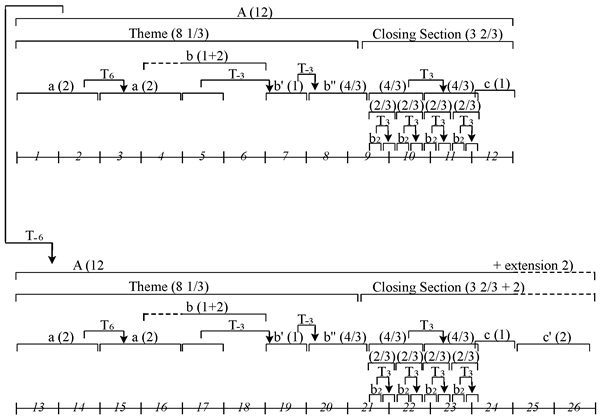
Example 1: Scriabin, Prelude Op. 74, No. 3.
Scriabin’s characteristic motivic economy is obvious in Example 2, where a limited number of motives generate the material and govern the grouping structure of the piece’s first part (and by extension, its second part), through repetition or transposition. To facilitate the discussion of the pitch and formal organization, the lay-out of the original score is modified in the example so that each of the three layers of the texture appears on a different staff. The generative motivic unit and its main variant are exposed in the melody of mm. 1–2 and 5–6 respectively. In the initial theme, the motive of mm. 1–2 recurs only once, in the tritone transposition of mm. 3–4 (with the addition of an eighth-rest at the beginning of the measure). In the variant at mm. 5–6 the first note of the motive is left out, and the end is changed by substituting a minor third for the ascending minor seventh skip. This new version in turn generates the material of m.7 and mm. 8–9. The last three pitches of this variant (moving one semi-tone down and three semi-tones up) fill up most of mm. 9–11.
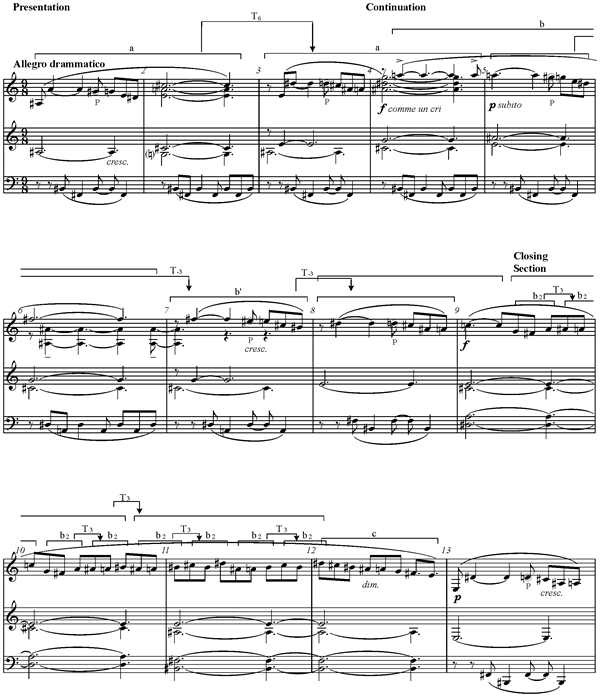
Example 2: Scriabin, Prelude Op. 74, no. 3, mm. 1–13.
Repetition (whether literal or varied) plays an important role in segmentation, and the relative uniformity of the Prelude’s grouping structure results from the recurrence of the first bar of both the motive and its main variant in every odd bar, for the first seven measures.[16] However, various factors prevent excessive grouping regularity: for instance, the segment in mm. 5–6 is lengthened by a prefix (the upbeat to m. 5) that uses up m. 4 almost entirely. This not only creates asymmetry between the initial 2-measure units and the subsequent 3–measure one, but it also produces an overlap at m. 4. Further along, in mm. 9–11, the motives destabilize the prevalent meter by establishing groups of four beats, shown as four thirds of a measure in Example 1 (contradicting the regular metrical accentuation, at every three beats).
Transposition is intimately linked to the effects of invariance and complementation in the pitch materials. If we consider the texture globally in mm. 1–4 (Example 2), we observe that the upper stratum progresses upward while the double pedal in the bass stands still. In mm. 1–2, if we exclude the passing G-sharp (circled in the example), the melody uses all but two pitches from the octatonic scale III, omitting the F-sharp and B-sharp, which are sounded in the bass (the inner voices all double notes from the melody). Therefore, melody and bass are complementary. That is, their combination creates an octatonic scale, while taken by themselves, the two strata do not overlap. The pitches from the melody C-sharp, D-sharp, E, G, A, A-sharp (ordered here, and subsequently in this article, according to Joseph Straus’s normal form) correspond to set-class 6-30, which is invariant at the tritone (i.e. it features transpositional symmetry).[17] Consequently, although the melody is transposed in mm. 3–4 and the bass stands still, the two strata use the same sets and remain complementary with respect to the octatonic scale. This represents a very sophisticated use of the complementation technique, and other instances of this procedure in Scriabin’s music suggest that this is a deliberate, conscious manipulation.[18]
In addition to octatonic complementation, Scriabin’s music also exploits transposition to generate the more familiar aggregate completion. The complement of octatonic scale III, with respect to the chromatic scale, is the diminished-seventh chord (2,5,8,11). In the first part, the generating motive and its variant are successively presented over the intervals of a diminished triad, at T0, T+6 and T+9, with the three chromatic passing-tones occurring on G-sharp (m.1 and m. 5), D (m.3), and F (m.7). When part two shifts the material from part one at T-6, the transposition of the chromatic passing-tone according to the diminished triad (mm. 13, 17, 15, 19) brings about the completion of the aggregate in m. 19 (not shown in the Example 2). This procedure, which has been discussed by James Baker in conjunction with other pieces, is by no means trivial, and represents a characteristic feature of Scriabin’s mature compositional technique. The use of this procedure is not particularly refined here, but the Feuillet d’album and particularly the Sonata no. 6 will offer more striking illustrations of it.[19]
The transposition relation at the tritone between parts one and two plays an important role in the local redistribution of the materials. As Dernova shows, it creates apparent exchanges in the vertical disposition of events or in temporal ordering, in spite of the global transposition of the restatement.[20] Since the transposition of the tritone by six semi-tones simply changes the register of the pitches, while maintaining the interval size and the pitch classes, the T-6 relationship of part two to part one produces on one hand the inversion of the numerous vertical occurrences of the tritone, and on the other hand the temporal reversal of the motives transposed at the tritone (that is, the exchange of their position in terms of temporal succession). Therefore, the melodic or harmonic interval of the lower stratum in mm. 1–12 is reversed in each measure at mm. 13–24 while preserving pitch-classes invariance. The same is true for the tritone intervals in the inner voices at mm. 2–7 and mm. 11–12. And since the initial 6–30 is invariant at the tritone (excluding the chromatic passing-tones of the motive), the same pitch-class sets are used in the second part; but they unfold in the reverse order of the initial melodic sequence. That is, while m.1 features the version starting with A-sharp and m. 3 the one beginning with E, the corresponding sets in m. 13 and m. 15 start with E and A-sharp respectively.
Besides a strong mutual connection, the grouping structure and the use of transposition technique are also closely related to the formal structure, both in the overall binary design, and in the internal dynamics of the phrases. Because of the historical ties that link the form to a tonal model, it seems unusual for a binary piece to to have material for its second part that is simply the transposition of material from its first part. The second part of a tonal binary form often begins with the presentation of the initial material in a new key, but the end is then adjusted so as to conclude in the home key. Scriabin exploits the properties of the transposition operator in such a way that the cadential chords of the first part reappear to close the second part, without abandoning the transposition relation. The end of each section (in mm. 11–12 and mm. 23–24) is based on the chord (4,6,10,0) in normal form (or more abstractly set 4–25, the French sixth sonority characteristic of Scriabin’s early compositions). This pitch combination is invariant at T6, enabling the composer to remain faithful to the traditional binary form while using literal transposition throughout.[21]
Furthermore, the end of part one and the beginning of part two are connected through linkage: the notes of the tritone played simultaneously in the bass in mm. 11–12 are presented melodically an octave lower in measures 13ff. In the upper stratum, the descending seventh, D-sharp to E, spanning the descending scale in m. 12, is inverted at the lower octave at the beginning of m. 13 (E to D-sharp).[22]
At the phrase level, transpositions and repetitions are exploited so as to express the various components of a Schoenbergian “sentence” (typically made up of a presentation, a continuation, and a cadence), and participate in important formal processes such as intensification, fragmentation, liquidation, and elimination. Here, concepts borrowed from the Formenlehre tradition developed by Schoenberg, Ratz, and Caplin are somewhat loosely applied, with modifications made to accommodate Scriabin’s practice.[23]
The presentation is expressed in mm. 1–2 and mm. 3–4. These bars establish a referential, two-measure grouping unit, and present characteristic material (the generative motive) with a distinct character, as well as melodic and rhythmic profile. Harmonically, set invariance under T6 can be compared to the kind of tonal prolongation associated with a statement/response type repetition of the basic idea in a standard tonal presentation. (That is, a basic idea centered on the tonic is followed by a version on the dominant.) Here the intensification, which usually takes place in the continuation, begins already in the presentation. The transposition of the initial measures brings with it a melodic progression that reaches its highpoint in m. 4—the actual climax of the piece, marked forte and “comme un cri.” The precise point where the continuation starts is ambiguous. On one hand, mm. 5–6 suggest another two-bar unit, to be transposed down and repeated in mm 7–8. But a complete transposition is cut off at m. 8, and we realize that fragmentation and liquidation are underway. Retroactively, we may reinterpret the passage as a continuation, and other elements help locate its inception as early as m. 5. After the climax of m. 4, a new wave of intensification is ushered in: the reversal of direction in melodic motion with the descending sequence creates a converging effect between melody and bass, fragmentation, and a crescendo, reaching a resting point at the beginning of m. 9 (which recaptures the forte dynamic). The closing section progressively liquidates the initial material, beginning in mm. 9–11 with a melodic sequence built on a fragment from the main motive in a uniform eighth-note rhythm, followed in m. 12 by a nondescript descending scale. Sequences are used abundantly at all levels of structure; however, their use is far from uniform and mechanical. They create sophisticated pitch-syntactical relations, and participate in a diverse array of formal processes.
[3] Sonata no. 6 op. 62
The tight coordination between grouping and form observed in the Prelude op. 74 no. 3 is not a characteristic unique to Scriabin’s miniatures. It also applies to his large-scale works, including those with more complex structures like sonata form. In what follows I provide some evidence to that effect with a survey of the general form of Sonata no. 6 op. 62, and a closer look at its main theme and transition sections. The piece is dominated by the octatonic scale, and only a few passages exploit non-collectional pitches.[24] Generally, these mild deviations may be subsumed under what may be called enlarged octatonicism (one that admits ornamental tones such as chromatic passing tones). But in few cases, they bring in new collections derived from the octatonic scale by chromatic inflections (as in mm. 43–46 and in such derivatives as mm. 162–166). According to Richard Taruskin, the three octatonic sets are used here as “referential collections, functionally akin to keys in the traditional sense.”[25] This conception of the work’s general design is reflected in Figure 1 (where Roman numerals indicate octatonic collections).
|
Exposition (1–123) |
Development (124–205) |
Recapitulation (206–305) |
Coda (306–386)
|
|
Main theme (1–38) Part 1 (1–14) : I Part 2 (15–38) : I (II) I |
Changes in collections[26] |
Main theme (206–41) Part 1 (206–18) : II Part 2 (219–41) II (III)II |
I (306–18) III II I (329–53) III II I (364–86)
|
|
Transition (39–81) Part 1 (39–54) : I ->III -> Part 2 (55–81) : I -> III |
|
Transition (242–66)
Part 1 (242–66) : II -> I |
|
|
Sub. theme (82–123) : III |
|
Sub. theme (267–304) : I |
|
Figure 1: Sonata no. 6, Op. 62.
In the exposition, the main and subordinate themes create a “collectional” contrast analogous to the traditional key contrast of sonata form, by the use of two different octatonic collections, I and III. Moreover, as I show later on, the transition section gradually moves away from collection I and establishes collection III, in the way a tonal transition destabilizes the main key and modulates to the subordinate key.[27] The material of the exposition is transposed a major second down in the recapitulation. As a consequence, the main theme is brought back in collection II—a scale that is different from the “tonic” or “referential collection.” Still, the second theme is correctly recapitulated in collection I, and the work closes in the “tonic” collection. In other words, the recapitulation begins outside the referential transposition of the octatonic scale for this piece, but it works its way back into it. This makes for a more dynamic recapitulation. This represents a radical departure from Scriabin’s early practice in his fully tonal sonatas, where recapitulations both begin and end in the tonic. At the same time, it is in keeping with new experiments undertaken in his tonally ambiguous Sonata no. 5 (where the recapitulation begins with material from the exposition transposed down a perfect fifth).[28]
The structural properties of the transposition technique that govern the large-scale level of the form, as we just saw, apply as well to the lower levels, ranging from the subdivision of formal sections all the way down to the small motives. Thematic sections favor transpositions at T3, T6, and T9, to keep the octatonic collection invariant. And transpositions at other intervals are used mostly in the transition and the development, to produce collectional shifts. As shown in Example 3, the main theme and transition (mm. 1–38 and 39–81) are each made up of two parts (mm. 1–14 and 15–38 for the main theme and 39–54 and 55–81 for the transition). In both cases, the second part is an expansion of the first (as emphasized in the layout of the example), and the expansion results from the transposition or repetition of motives—a typical type of expansion in Scriabin. In the main theme, the transposition operator maintains the octatonic collection (with straightforward repetitions or T0, and sequences at T3). There is only one exception in mm. 31–34, where T-2 effects a brief shift, yielding quickly to T-1, which brings back the initial collection (T-2 + T-1 = T-3). In the transition, a new collection is first introduced in the first part, due to a sequence at the upper major second in m. 47, and it is prolonged through a tritone transposition. The T-8 sequence brings back the initial collection in time for the expanded repetition of the first part in mm. 55–82. Again, the collectional shift is triggered by the sequence at the upper major second, but this time, it is maintained (in part through repetition and T6 sequence) until the onset of the subordinate theme. It is as if the first aborted attempt to “modulate” actually served to destabilize the initial referential collection and anticipate the second one (a procedure analogous to what Schenker calls the “eye of the modulation”).
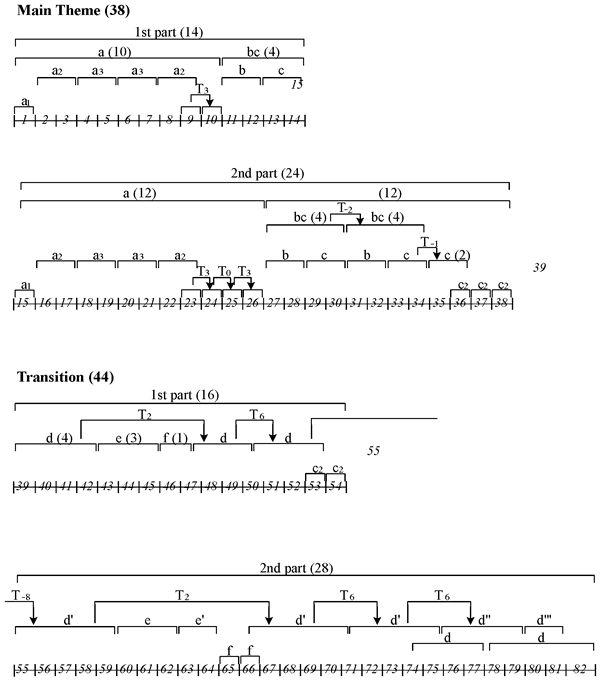
Example 3: Scriabin, Piano Sonata no. 6, Op. 62, mm. 1–82.
The main theme loosely adopts the formal design of a sentence. Example 4 shows the form of the first part (which applies equally to the second part, except for the adjustments required by the expansions). Measures 1–9 function as a presentation through statements of characteristic and referential material, emphasized through repetition, temporal expansion, and stability (which constrasts with subsequent motivic and textural development). In the first measure, set (5,7,8,10,11,1,2), that is, octatonic scale I excluding E, exposes the pitch material for the whole presentation. The continuation that begins in m. 10 generates intensification through fragmentation, crescendo, acceleration of the surface rhythm, and ascending melodic motion that reaches its highpoint at the beginning of m. 12. It is followed by descending motion, decrescendo, and liquidation, characteristic of the cadential function, and leading to a close on the prolonged chord at m. 14.
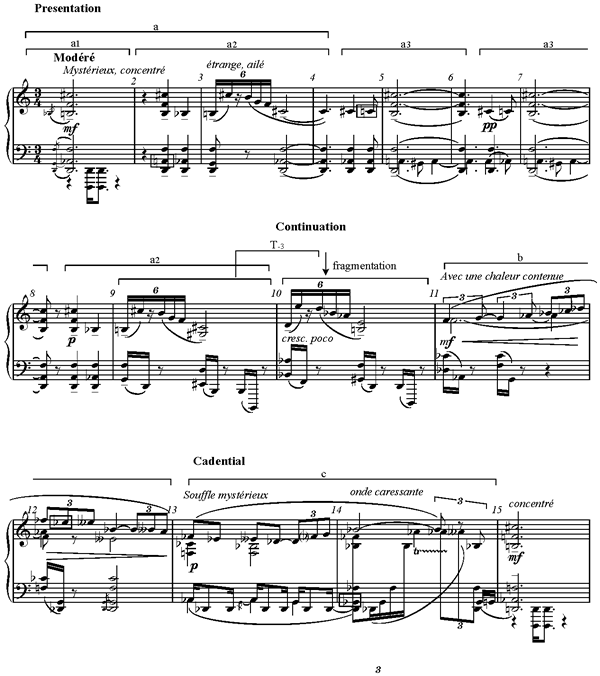
Example 4: Scriabin, Piano Sonata no. 6, Op. 62, mm. 1–15.
The pitch organization of the first part shows the importance of complementation, both with respect to the octatonic and the chromatic scale. In the main theme, the complementation in the octatonic collection rests on the transposition properties of set class [0268]. When two specific instances of this set are related by T3, they represent two complementary, non-overlaping segments of the octatonic scale. In Example 4, the sextuplet motive, based on set class [0268], is presented first on (1,5,7,11) in measures 3 and 9, and it is transposed in m.10 on (4,8,10,2). Since all the pitches from the octatonic scale except the E were introduced in the first measures, the transposition brings forth the missing pitch, emphasized by its placement as a melodic highpoint. The same complementary forms of the set are subsequently superimposed in m. 12 in the left and right hands (thus producing a very dense statement of a complete octatonic collection). This marks the culminating point of the crescendo that began in the preceding measure, underscored by the composer’s indication “avec une chaleur contenue.”[29] Aside from the complementary property governing its T3-related pairs, the [0268] set is invariant under T6. Scriabin exploits this feature in the second part of the main theme (not shown in Example 4), where two successive transpositions of the sextuplet motive (mm. 23–26) produce T6 invariance.
Some aspects of the cadential organization of the main theme deserve discussion, for their subtlety, and as further illustration of the tight bond that unites pitch organization, grouping structure and form. The complementary pitches of octatonic collection I that are used in the main theme make up the diminished seventh chord (0,3,6,9). In Example 4, these non-collectional pitch classes are boxed in their first occurrence. The A, C, and E-flat are introduced respectively in m. 2 (appoggiatura to the A-flat, or neighbour-note if we consider a longer connection to the preceding A-flat in m. 1), m. 4 and m. 12 (both passing notes). The final non-member tone, G-flat, is heard on the first beat of m. 14 as the root of a dominant ninth chord.[30] It is given special prominence through its very strategic location: it occurs in the final measure of the first part, just before the return of the opening material in m. 15. The G-flat is not treated as an ornamental tone, but as a structural pitch of the chord (the root of the chord at that). Moreover, Scriabin seems to emphasize the characteristic fullness and sensuality of this resonant chord by expanding it (to cover almost an entire measure), spreading it out through arpeggiation that culminates in a trill, and underlining the effect with a suggestive performance marking (’onde caressante,” or “caressing wave”). This moment is also set apart because this chord is impossible to realize in the octatonic scale (it reappears several times throughout the sonata, often as a subset of the acoustic scale).[31] This underscores the expressive purpose of aggregate completion, and its tight relationship to the form.
The end of the main theme in mm. 27–38 (Example 5) creates a rhyme between the endings of parts one and two, using, in both cases, the approach to the cadence and the concluding material, segments b + c. (The “c” segment recurs even in mm. 53–54, at the end of the first part of the transition, again functioning as a concluding gesture.) But the conclusive effect is reinforced in the second part, because the combination of transposition and fragmentation produces marked liquidation and elimination (it now covers twelve measures instead of two!). The transpositions are not literal though, as one pitch (C-sharp/D-flat) is maintained invariant in a fixed register. Indeed, the high D-flat of m.30 is respelled as C-sharp in m. 34 (boxed in on the example), returning to the D-flat spelling in m. 36, while the group in mm. 31–34 is transposed a whole-tone down from mm. 27–30, and the two-measure unit mm. 35–36 is reproduced one semi-tone down from 33–34. In the next two measures (mm. 37–38), all the notes of the chord are progressively altered, except the D-flat, which is retained. This pitch serves as a link in that it foreshadows the first note of the transition melody (and it also recalls the melody of the main theme, which began with the enharmonic C-sharp in the very same register). Scriabin singles out the invariant pitch from the outset, by marking it with a tenuto in m. 30 and m. 34. The linkage is combined here with a very dynamic effect, almost paradoxical in nature, whereby the elimination and liquidation of characteristic material, performing a conclusive function, generates what becomes retrospectively the characteristic, emblematic material of the next section.[32]
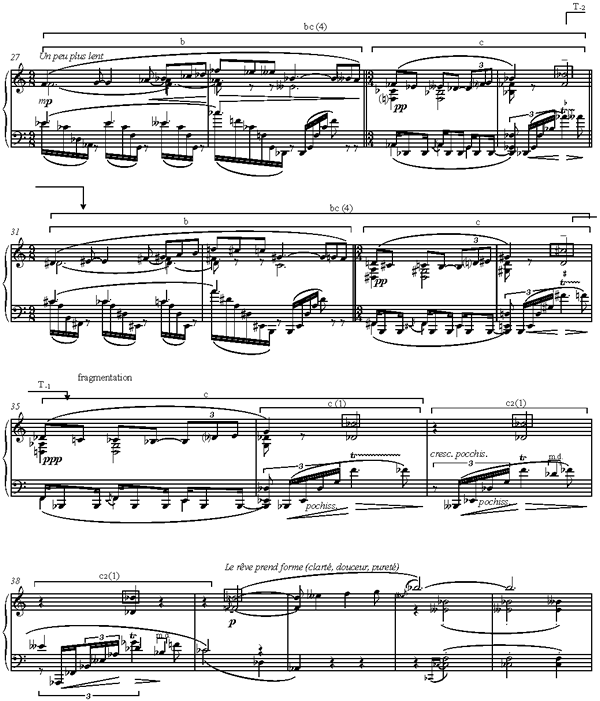
Example 5: Scriabin, Piano Sonata no. 6, Op. 62, mm. 27–42.
In the transition, as in the main theme, the second part expands the proportions of the first one and provides a link to the next section (the subordinate theme). Comparing Examples 6a and 6b highlights an important factor contributing to the expansion. Corresponding passages from the first and second parts feature the same melodic motive (D-flat, E-double flat, F, G, B-flat), but the second time, a compression in eighth-note rhythms is nested in just before the arrival of the last note of the original motive (mm. 57–58). Each further recurrence of the motive interpolates a similar diminution before the last note, which contributes to the global expansion of this part.[33] From another perspective, this diminution prepares the subordinate theme, which is built on an even faster diminution of the same motive, which sounds like an arpeggiated chord (see the quintuplets in Example 6c, m. 82). At the end of the transition (m. 81), the last compression of the motive is accelerated, serving as a rhythmic link to prepare the faster figure of the subordinate theme.
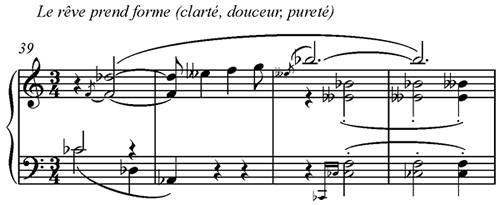
Example 6: Scriabin, Piano Sonata no. 6, Op. 62 , a) Transition, mm. 39–42

b) Transition, mm. 55–59.

c) End of the transition and beginning of the subordinate theme, mm. 80–83.
[4] Feuillet d’album Op. 58
Sonata no 6 and Prelude op. 74 no 3 have provided exemplary illustrations of the mature Scriabin’s organizational procedures in the octatonic idiom. A third work, Feuillet d’album (ca 1909), will now show how these procedures operate in the context of a different idiom, in music based on the so-called mystic chord. Feuillet is based on two sets (labelled “x” and “y” in Example 7a) that are both members of the same 6-34 set-class (black note-heads used in y refer to pitch doublings in the upper register.) In Example 7b the mystic chord appears in a passage that has a pitch center of B (with its canonical stack of fourths, whether pure, augmented or diminished). A comparison of the chords in Examples 7a and 7b reveals that all three contain the same six pitch-classes, and that they differ only in the disposition of intervals within the verticality. Nonetheless, the distinction between the two dispositions of 6-34 is important for the analysis of the piece. First, the work is based exclusively on literal transpositions from those two sets; second, their invariance properties are exploited for structural purposes.
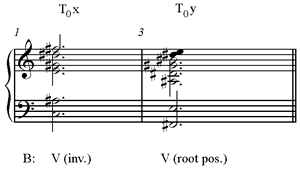
Example 7a: Feuillet d’album Op. 58.
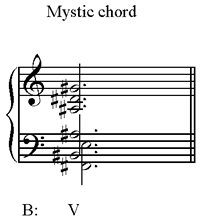
Example 7b.
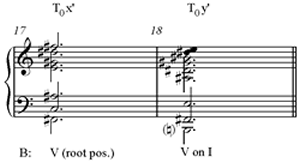
Example 7c.
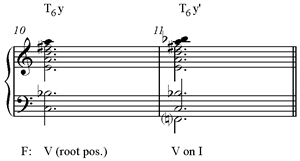
Example 7d
Examples 7c and 7d show other forms of the generative sets. In Example 7c, I use the labels “x′ ” and “y′ ” to refer to versions of the opening chords with an added pitch. In spite of Feuillet d’album’s elusive, fleeting tonality, hexachords “x” and “y” function as dominant chords, and the T0 chords at the beginning and end define an overall B pitch center. In “x′ ”, the root of the chord is placed in the bass, underneath the pitches of the x chord, and in “y′ ”, the added bass note is B, the main pitch center of the piece. Most of the time, the tonic is implied in the piece, but not expressed. Yet in functional terms, it is as though “y′ ” produced the dominant harmony over tonic pitch (as a V on I). Chords “x” and “y” do not always appear at their initial pitch level, and they are sometimes transposed to express various pitch centers. Example 7d shows the transpositions that suggest a pitch center of F in mm. 10–11.
Example 8a contains the score of the whole piece with its main groupings. A harmonic reduction with chord labels is provided in Example 8b below it. The piece is cast in an overall ABA′ form, made up of 8 + 7 + 8 bar groupings. In the B section, a sense of contrast arises from the adoption of a new three-part texture (resulting from the addition of an inner voice), and the presentation of new motivic material.
Example 8: Feuillet d’albumOp. 58, grouping structure and harmonic reduction. Click on each part of the image to see an enlarged version.
Again, as we saw in the mature works, repetition and transposition techniques are prominent at various levels: the 8-bar section A is based on a 4 bar grouping that is subsequently transposed up a tone (and as we saw, each four-bar segment is itself based on one chord and its permutation). The B section is generated by fragmentation and compression of a phrase: the 2 1/6 bar closing fragment in mm. 11–12 is detached from the end of the initial 3 2/3 grouping, and it is repeated with compression and melodic liquidation in mm. 13–15. A new melody creates contrast in section B, but in other ways, this section is closely related to materials from section A. Its harmony uses various transpositions of chords “x” and “y” (see T10y, T6y, T6y′ and T0x in the harmonic reduction). More obviously, fragments from the accompanimental pattern in section A recur in transposition (see the brackets below the bass staff in mm. 3–4, 7–8, 11–12, 13–14, and further into the A′ section in mm. 18–19, 20–21). The A′ section begins in m. 16–19 with a restatement of the first four bars of section A with a varied accompaniment, and continues with fragmentation and elimination of mm. 18–19 (the fragmentation is indicated by the arrows). In other words, most of the material is derived from mm. 1–4, through repetition and transposition, even at the beginning of the contrasting B section.
These preliminary considerations show some of the ways that grouping structure mediates between form and pitch organization. Other, more circumscribed observations reinforce this. A crucial moment in the large-scale pitch organization occurs at the juncture of sections B and A′ in which a “short circuit” occurs between the chords in mm. 10–14 and m. 15 that highlights the transpositional properties of sets “x” and “y.” This may be explained first by comparing the T0x from mm. 15–16 with its corresponding tritone-related chord in m. 3 (which recurs in mm. 18–19 with the addition of a B in the bass—see Example 9a). Four common pitch-classes may be observed (C/B-sharp, B-flat/A-sharp, E, and F-sharp), and this corresponds to the maximal pitch-class invariance of 6-34 chords under transposition. But the refinement of the structural relationship does not end there. The T6y′ and T0x at mm. 10–14 and 1 (and its recurrence in m. 15) are also tritone-related forms of 6-34 (see Example 9b). Consequently, they have the same four common pitch-classes observed in Example 9a. But this pair of chords produces strikingly smooth voice-leading.
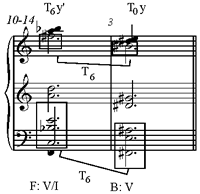
Example 9a: Feuillet d’albumOp. 58, harmonic reduction mm. 10–14 and 3.
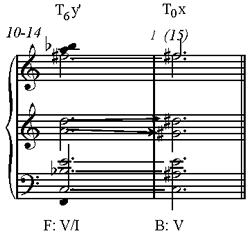
Example 9b: harmonic reduction mm. 10–14 and 1 (or 15).
With T6y′and T0x, a direct registral connection is established: the common pitch-classes remain invariant in the same registers, and the two remaining pitches move by half-step. This voice-leading connection is emphasized in the chordal unfolding of the actual realization, as may be observed by comparing mm. 11–12 with mm. 1–2, or its recurrence in mm. 16–17. Example 10 shows that the corresponding pitches of the two chords are introduced in the same temporal order. Note that in the left hand of mm. 1–2, the structural pitches that are related by semi-tone shift are marked with tenutos.

Example 10: Feuillet d’album op. 58, mm. 10–12 and 1–2 (or 16–17).
The descending melodic fourth in the left-hand of T6y′ and the descending fifth of T0x are emphasized from the outset in the opening generating fragment of mm. 1–4, both occurring on the melodic dyad D-sharp-G-sharp (Example 11). If we follow them in their temporal unfolding, the initial descending fifth, marked with tenutos in the left hand, is quickly echoed by the right hand in the same register. And after the right hand reaches its melodic cadence in mm. 3–4, the dyad is inverted in the left hand, still marked with tenutos.
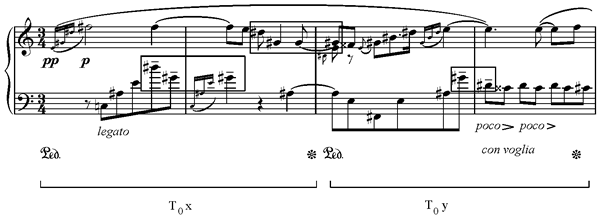
Example 11: Feuillet d’albumOp. 58, D-sharp- G-sharp dyad in mm. 1–4.
Since both “x” and “y” are forms of 6-34, T6 of either set produces four common pitch-classes. But it is impossible to produce full invariance in the appropriate registers if either “x” or “y” are combined with their respective T6. The only possible way to achieve this is to choose two different dispositions of 6-34 that relate as closely as possible to T6. That is the case with “x” and “y” (compare the chords in Example 7a), and that is what makes the registral connection of Example 9b possible. This important feature underlies the analytical relevance of distinguishing between the two different permutations of the Mystic chord (“x” and “y”), but it has escaped notice in all previous analyses of this piece.
From a formal standpoint, the main characteristics of the ternary form are suggested in my previous discussion of repetitions and transpositions. At this point, I would like to briefly reiterate some of my points and provide some additional analysis to complement my argument. First, it is worth restating that the main formal articulations of the ternary form are clearly delineated, through both the use of contrast at the beginning of section B, and the return of the opening material at its initial pitch level to initiate the A′ section. At the end of both the B and A′ sections, fragmentation and liquidation combine to create a conclusive effect. It is also significant that all three sections begin with the same F-sharp4. As we saw, Scriabin later reused a similar procedure in the exposition of Sonata no. 6, where the same C-sharp4/D-flat4 marked the beginning of both the main theme and transition. But in Feuillet d’album, the articulation between the end of the A section and the beginning of B is somewhat obscured by the sentential organization that underlies mm. 1–15. Example 12 offers a double analysis of the formal functions for this passage. Components of the small ternary are shown above the measures indicated in the middle axis, while the main parts of the sentence are indicated below it. In the presentation section, an initial compound basic idea introduces the characteristic motivic material and the referential chords within a standard four bar grouping. It is then repeated sequentially at T2 in m. 5–8.[34] After the presentation has established the norms for grouping, motivic material and referential harmony, the beginning of the continuation produces instability, and the sentence ending creates a sense of closure. The instability results from fragmentation, and the variety of transpositions of sets “x” and “y”. A sense of closure is established through liquidation and the return to the initial chord.

Example 12: Feuillet d’albumOp. 58, formal analysis mm. 1–15.
Further insight into the rationale for Scriabin’s transposition technique and its role in large-scale form may be gained from looking to three structuring elements: the chromatic segment (B-sharp-C-sharp-D-D-sharp); melodic highpoints; and the motivic cell [048] (see Example 13). As we saw earlier, the B section has a new three-part texture, and the middle voice introduces an ascending chromatic segment (see the bracketed B-sharp-C-sharp-D-D-sharp in mm. 9–15). In fact, this chromatic segment is actually a broad augmentation and inversion of the chromatic descending motive found in mm. 4–5 (using the same pitch-classes). Voiced in the left hand, this segment links the first four bars of the piece to their transposition up a step in the next four bars. The chromatic segment acquires its full significance once a special status is conferred on the final D-sharp in section B (on the upbeat to m. 15). In this same section, ten notes from the twelve-tone aggregate are worked in, and D-sharp is the only pitch-class from the final chord of B, T0x, that is absent from the two previous chords from that section. So the arrival of the fresh D-sharp is held back for the end of the section, where it signals the return of the initial chord (m. 15). This special effect of control in the introduction of pitches, and planned arrival as part of a special chord and strategic formal articulation, was later used in Sonata no. 6, as noted above. In the sonata, the arrival of the special pitch coincided also with the completion of the twelve-tone aggregate. Chromatic completion also occurs in the Feuillet d’album, but in a different context. As James Baker has perceptively observed, the delayed arrival of the work’s tonic in m. 18 not only allows confirmation of the pitch center to be postponed until the final chord of the piece, it also finally brings the aggregate to completion.[35]
Example 13: Feuillet d’albumOp. 58, reduction. Click on the image to see an enlarged version.
Also closely coordinated with form and transposition-levels is the distribution of the melodic highpoints throughout the piece. The “x′s” that identify these highpoints in 13 follow a gradual step-wise ascent (see mm. 1, 5, 11, 13 et 22).[36] The F-sharp and A-flat in mm. 1 and 5 result from the transposition of the first four bars; the next expected pitch in the ascending sequence, the B-flat4, should have appeared already in m. 9 with the T10y. This chord is the only one to have its registral disposition altered (see the harmonic reduction in Example 8b, m. 9). Scriabin displaces the pitch two octaves down (marked with a hairpin in the left hand). The arrival of the B-flat in its proper register is delayed until mm. 11 and 13, so that the climax coincides with the melodic cadence at the end of the phrase. The change in register at m. 9 is thus justified by considerations that pertain both to agogic and formal organizations. The next pitch in the chromatic ascent, B-sharp, is introduced in m. 22, and results from a series of T4 cast over the melodic arrival on E4 in m. 18. This develops the material from the surface of the same bar (m. 18), in composing out an important subset of 6-34, the augmented triad, [048], which is introduced for the first time in m. 3 (see the blocks in the example).
[5]
Scriabin’s abundant use of repetitions and sequences has often been severely criticized as a mechanical procedure, denoting formal indigence—perhaps as the result of being judged (consciously or not) against the aesthetic canon of the Second Viennese School, and its infatuation with “musical prose.” But Scriabin’s redundancies perform an important role: in terms of his compositional craft, they do not result from an involuntary writing tic, which would manifest itself anarchically and arbitrarily. On the contrary, their distribution over various hierarchical levels leads them to play a primordial role in the pitch syntax, and in the formal characterization of the music.[37] And beyond their purely technical purpose, sequences and repetitions affect the expressive character of the works—they help convey an obsessive, hypnotic character, which may be linked to the composer’s mystical endeavors.
This tight bond between formal organization, style and musical experience can be illustrated even in the most tenuous and fugitive moments. I believe a good example of this would be the passage I described in the Sonata no. 6, where Scriabin creates a striking musical effect by placing a dominant chord (emphasized through expansion and a trill) amidst an otherwise octatonic passage. Scriabin draws the attention of the performer with the marking “onde caressante,” and the detailed analysis of the passage has established how this also signals a crucial moment in the form (as a cadential chord that marks the end of the first part of the main theme, and completes the aggregate). A further step along this interpretative path would lead to an exegesis of Scriabin’s mystical ideas as they come across his music, a step that I will not dare take here, but that has been brilliantly attempted by others.[38]
Music historians have frequently praised the audacity and the innovative character of Scriabin’s oeuvre. Numerous comparisons may be made with the advances of his contemporaries, in particular those of the Second Viennese School, in regard to the exploitation of the musical material’s properties, the new structural role assigned to aggregate completion, and the rigorous manipulation of the various parameters. Yet despite the similarities, the composer himself showed little interest in the kind of token avant-guardism, as valorized by teleological views of history.[39] Scriabin’s attitude toward his colleagues’s new compositions is telling. During his tenure on the advisory board of Koussevitzky’s Russian Music Edition (Rossiiskoe Muzykalnoe Izdatel’stvo), Ossovsky recalls Scriabin’s desire, “to open the doors of the firm to innovation…the most important thing was to ascertain if the composer had a creative principle, if so, find it, and evaluate the work according to adherence to his principle which, in turn gives birth to his style.” Nonetheless, this same testimony reveals that the egocentric composer was typically, “indifferent to all alien music and very weak at reading from the written page…He accepted or rejected at sight, without analysis.”[40] Thus, in a kind of projection typical of the composer’s character, the method he adopts for (supposedly) judging his colleagues appears more like a template handed down to us for contemplating his own creations. From this perspective, the elaboration of an eminently rigorous musical system responds to a higher necessity: to define a unique style and a prophetic voice, of compelling expressive power. By his own standards, Scriabin might be said to have succeeded entirely, and with his works, well-deserving of a much needed critical revaluation.
Notes
[1] My warmest thanks go out to the people who have helped me with the realization of this article: for the revision of the English text, I am indebted to Elizabeth Blackwood, Nora Engebretsen, and especially Catrina Flint de Médicis. I also extend my thanks to Jon-Tomas Godin who helped me with several of the musical examples.
[2] Quoted in Faubio Bowers, The New Scriabin: Enigma and Answers (New York: St. Martin's Press, 1973), 128.
[3] Boris de Schloezer, Scriabin: Artist and Mystic (Berkeley and Los Angeles: University of California Press, 1987), 57.
[4] Bowers, The New Scriabin, 129.
[5] Anthony Pople, Skryabin and Stravinsky, 1908–1914: Studies in Theory and Analysis (New York: Garland, 1989).
[6] Especially in the writings of Jame s Baker and Richard Taruskin. From James Baker, see “Scriabin’s Implicit Tonality, ” Music Theory Spectrum 2 (1980), 1–18; “Schenkerian Analysis and Post-Tonal Music,” in Aspects of Schenkerian Theory, ed. David Beach (New Haven: Yale University Press, 1983), 153–186; and The Music of Alexander Scriabin (New Haven: Yale University Press, 1986). From Richard Taruskin, see “Chernomor to Kashchei: Harmonic Sorcery; or, Stravinsky’s ‘Angle’,” Journal of the American Musicological Society 38 (1985), 72–142, slightly reworked in Stravinsky and the Russian Traditions: A Biography of the Works through Mavra (Berkeley: University of California Press, 1996), 255–306; also “James M. Baker, The Music of Alexander Scriabin, and Schloezer, Scriabin: Artist and Mystic [review],” Music Theory Spectrum 10 (1988), 143–169; “Scriabin and the Superhuman: A Millennial Essay,” in his Defining Russia Musically: Historical and Hermeneutical Essays (Princeton and Oxford: Princeton University Press, 1997), 308–359; and ’Extinguishing the “Petty I′ (Transcendentalism, I). Scriabin, Messiaen,” in his The Oxford History of Western Music, vol. 4 (New York, Toronto: Oxford University Press, 2005), 191–227.
[7] Robert Morgan, ‘Dissonant Prolongation: Theoretical and Compositional Precedents,” Journal of Music Theory 20/1 (1976), 49–91, and Baker, ’Schenkerian Analysis and Post-Tonal Music.”
[8] George Perle, Serial Composition and Atonality: An Introduction to the Music of Schoenberg, Berg, and Webern. 6th ed., rev. (Berkeley: University of California Press, 1991), 41–43.
[9] Besides the studies by Baker and Taruskin already mentionned, see Jay Reise, “Late Skriabin: Some Principles Behind the Style, ” 19th-Century Music 6/3 (1983), 220–231; George Perle, “Scriabin’s Self-Analyses,” Music Analysis 3 (1984), 101–122, reprint in The Right Notes: Twenty-Three Selected Essays by George Perle on Twentieth-Century Music (Stuyvesant [N.Y.]: Pendragon Press, 1995), 3–26; Elliott Antokoletz, Twentieth-Century Music (Englewood Cliffs: Prentice Hall, 1992), 100–104; Cheong Wai-Ling, “Orthography in Scriabin’s Late Works, ” Music Analysis 12/1 (1993), 47–69, and also by the same author, “Scriabin’s Octatonic Sonata,” Journal of the Royal Musical Association 121/2 (1996), 206–228.
[10] Clifton Callender, “Voice-Leading Parsimony in the Music of Alexander Scriabin,” Journal of Music Theory 42/2 (1998), 219–233.
[11] See Faubion Bowers and Philip Ewell’s appraisals of Varvara Pavlovna Dernova’s and Yuri Kholopov’s theories respectively. For instance, Bowers claims that “for the first time, Scriabin’s code of chordal and melodic construction was broken. (…) Dernova definitively analyzes the system which Scriabin created and practiced” (The New Scriabin, 131). Philip Ewell’s article is “Scriabin's Seventh Piano Sonata: Three Analytical Approaches,” Indiana Theory Review 23 (2002), 23–67.
[12] Leonid Sabaneev, “A. N. Skrjabin,” Melos-Zeitschrift für Neue Musik (May 1925), p. 463.
[13] Bykov’s observations are reported in Bowers’s The New Scriabin (London, 1974), 149. A letter to Tatiana de Scloezer written by Scriabin while he was working on the Poème de l’Extase also attests to the time and energy the musician spent working out a formal outline in the early compositional stages. The letter, dated January, is quoted in Manfred Kelkel, Alexandre Scriabine: sa vie, l'ésotérisme et le langage musical dans son œuvre (Paris: éditions H. Champion, 1984), 55.
[14] Though the analytical and theoretical literature on Scriabin has traditionally centered on the pitch organization, other parameters (especially the grouping structure) have not been ignored. Nevertheless, pitch organization has always been the primary focus, and there has been made no deliberate attempt to rigorously thematize the interaction of multiple parameters from a global perspective. For instance, in Skryabin and Stravinsky, Anthony Pople borrows Jean-Jacques Nattiez’s paradigmatic approach to study the grouping structure of Scriabin’s music; however this aims to solve the problem of set delineation in set theory, that is, to provide objective criteria that could inform the parsing of the musical surface. In Alexandre Scriabine: sa vie, l'ésotérisme et le langage musical, Kelkel analyzes the music’s grouping structure using the methodology of Conyus (a Russian theorist with whom the composer had studied). In this case, the grouping analysis is performed for its own sake, to highlight symmetries and reveal the overall balance of the compositions. There is little attempt to coordinate the segmentation with the analysis of the pitch structure. Several scholars make interesting observations about grouping structure and form, without generalizing about their mode of interaction, such as George Perle, “Scriabin’s Self-Analyses” (see for instance his analysis of the Prelude op. 74, no. 5, 107–108), James Baker, The Music of Alexander Scriabin, and Cheong Wai-Ling, “Scriabin’s Octatonic Sonata.” A short digression on James Baker’s contribution is in order, given the depth of his insights into the interaction among parameters. His comprehensive outlook was almost inevitable, given his adoption of a hierarchic and linear perspective; as for this approach to be legitimate at all, it had to take a variety of parameters into consideration (at least implicitly). As a result, references to this interaction occasionally surface in Baker’s comments, as in his analysis of Feuillet d’album (129–135). A section entitled “compositional procedures” (7–11) provides very valuable observations on grouping structure, in particular for issues of invariance and contrast. However, it neglects to a great extent the formal dimension. In the section on “Periodic Structures” (17–20), Baker analyzes only one piece later than the Sonata no. 5 (the étude op. 56, no. 4), and limits the discussion to the congruence of harmony, cadence, and periodic structure. But this is in keeping with his overall goal, namely to describe the modalities of the transition from tonality to atonality in Scriabin’s music. Taruskin’s review of the book in Music Theory Spectrum [10 (1988), 143–169] does not entirely do justice to Baker’s significant contribution (and the reviewer’s judgment is more fair in Defining Russia Musically, 314–315); however he presciently identifies shortcomings and topics requiring further research. One of these is particularly relevant for my study: Taruskin takes Baker to task for criticizing Scriabin’s conservative grouping structures, reproaching him for failing to link it to the composer’s interests in symmetry and transpositional and inversional invariance (151–152). This critique, which goes to the heart of the matter, has never been fully addressed in Scriabinian research, and represents one of the challenges I have tried to tackle in this study.
[15] According to Pieter Van den Toorn’s classification, the octatonic scales starting with a semi-tone from C-sharp, D and D-sharp, or pitch-classes 1, 2 and 3, are labelled with Roman numerals I, II, and III respectively. Therefore, the octad I corresponds to (1,2,4,5,7,8,10,11), II to (0,2,3,5,6,8,9,11), and III to (0,1,3,4,6,7,9,10).
[16] The important role of repetition and parallelism as factors in segmentation is studied by Nattiez and Lerdahl and Jackendoff. As mentioned in an earlier footnote, Nattiez’s paradigmatic methodology was borrowed by Pople to study the grouping structure in Scriabin. See Jean-Jacques Nattiez, “Varèse Density 21.5: A Study in Semiological Analysis,” Music Analysis 1/3 (1982), 243–340 and Fred Lerdahl and Ray Jackendoff, A Generative Theory of Tonal Music (Cambridge: The MIT Press, 1983).
[17] Joseph Straus, Introduction to Post-Tonal Theory, 3rd edition (Upper Saddle River [N.J.]: Prentice Hall, 2005), 35–38.
[18] To my knowledge, complementation within the octatonic collection has gone unnoticed in Scriabin’s music heretofore. In two cursory analyses of Scriabin’s Prelude op. 74 no. 3, Elliott Antokoletz describes the invariant property of the bass tritone interval but does not mention the invariance of set 6-30 and the complementary relation between the right and left hands within the octatonic collection. Perle views this passage not in terms of complementation, but in terms of inversional equivalence. See Elliott Antokoletz, The Music of Béla Bartòk. A Study of Tonality and Progression in Twentieth-Century Music (Berkeley: University of California Press, 1984), 10–11, and Twentieth-Century Music, 100–104, and Perle, “Scriabin’s Self-Analyses,” 119.
[19] In The Music of Alexander Scriabin, Baker discusses the technique of complementation within the chromatic collection. In his article ’Scriabin’s Music: Structure as Prism for Mystical Philosophy,” he speculates on its symbolic meaning. He mentions various combinations of complementary sets within the aggregate: whole-tone collections (76–77), octatonic subsets (p. 78) and others. He even envisions it from a formal angle, when he considers how a theme based on set 8-24 uses the complementary set 4-24 to mark the cadential articulation (77–78). His symbolic interpretation invokes theosophy, where “the Unifying Principle is understood to have been differentiated into various planes of matter and spirit.” For Baker, the complement relation would illustrate this differentation, “embodying within the microcosmos of the universe of twelve pitch classes the aspiration toward unification.” This procedure was important enough to him that he criticized Morgan for failing to mention complement relations in the Enigme op. 52 no. 2 (p. 169).
[20] Varvara P. Dernova, Poslednie preliudii Skriabina (Moscow: Musika, 1988), 48–53.
[21] Robert Morgan discusses similar transposed repetitions in Scriabin’s periods and binary pieces (as well as in themes from other composer’s works) in “Symmetrical Form and Common-Practice Tonality,” Music Theory Spectrum 20/1 (1998), 1–47. First, he studies several transpositions at the perfect fifth from works of Scriabin’s early and middle periods, and finally, one instance of tritone transposition from the late period, the Poem op. 69 no. 2. This work is very similar to the Prelude op. 74, no. 3 in that it assumes a binary design in which the second part is transposed at the tritone. But each piece creates closure through different properties of the tritone transposition. As Morgan shows, the Poem is based on a loop in a cycle of T6, and the closure results from the completion of a cycle. The initial material, first transposed at the tritone at the beginning of the second section, returns to its initial pitch level in the last measures, through an additional T6. This is in opposition to the Prelude, where rhyming endings result from invariance in strictly transposed material. Also, the surfaces of the two pieces are saturated with surface tritone relations; and the effect of tritone invariance I discussed in the two parts of the Prelude is similar to what Morgan observes in the Poem. Finally, Morgan shows how the first part effects a change in emphasis from one note of the tritone to the other (D-flat to G), and how this is reversed in the second part (as a consequence of the tritone transposition). The same effect occurs in the Prelude (although from the perspective of Wai-Ling’s theory of scale-orthography, the whole piece maintains the single pole of F-sharp throughout the piece).
[22] In the little codetta of mm. 25–26, the final chord can be analyzed as the subtle combination of three important elements: the single pitch G, and the dyads F-sharp/B-sharp and E/D-sharp. The G melodically resolves the descending line from the previous measure. The two dyads correspond to the first two pitches played by each hand respectively in m. 13 (and the tritone dyad was heard in the bass as a double pedal for more than half of the piece). Moreover, the E/D-sharp dyad is delicately underscored in m. 26 because the first pitch is anticipated as a grace-note, and the second is emphasized as the top note of the chord.
[23] See Arnold Schoenberg, Fundamentals of musical composition (Boston: Faber, 1970), Erwin Ratz, Einführung in die musikalische Formenlehre, 3e ed. (Vienne: Universal edition, 1973), William Caplin, Classical Form: A Theory of Formal Functions for the Instrumental Music of Haydn, Mozart, and Beethoven (New York: Oxford University Press, 1998). The application of Schoenbergian formal functions to Scriabin’s music is foreshadowed in Cheong Wai-Ling’s “Scriabin’s Octatonic Sonata,” 214–215. The relevance of this approach for the music of Scriabin in general, and legitimization of its adaptation for the late works more specifically, is supported by consideration of the composer’s entire output. For example, relatively traditional instances of sentences are very common in the early works, as exemplified at the beginning of four Etudes from op. 8 (including the canonical sentence from mm. 1–8 of the Etude no. 8 in A-flat) and about a third of the 24 Preludes op. 11. In spite of the liberties in application in the late works, I opted for this formal model because of its familiarity to the scholarly community and because it links Scriabin to an historical lineage, a tradition that he appropriates. However, it is important to realize that the composer does not simply mechanically reuse outmoded conventions, choosing instead to exploit the dynamics that underlie them to new ends. We could substitute the three phrase functions of presentation, continuation and cadence, for the more abstract “temporal modes” of initiating, middle, and closing functions. These modes actually inform much of the following discussion implicitly. I examine these categories further in two studies: “ Les conventions de l’opéra au XVIIIe siècle et les oeuvres lyriques de Mozart”, In Jean-Jacques Nattiez (ed.), Musiques: Une encyclopédie pour le XXIe siècle, volume IV (Paris: Actes Sud/Cité de la musique, 2006), 911–936 (the original version appeared in the Enciclopedia della musica [Turin: Einaudi, 2004], 658–681) ; and in my unpublished Ph.D. dissertation, “La spécificité des thèmes à retour dans l’oeuvre instrumental de Brahms” (Montreal: McGill University, 1998).
[24] A first, albeit cursory, discussion of the use of octatonic scales and non-collectional tones in this sonata is found in Taruskin, “Chernomor to Kashchei,” 99. Cheong Wai-Ling proposes a more detailed account in “Scriabin’s Octatonic Sonata,” 209–211.
[25] Taruskin, “Chernomor to Kashchei,” 99.
[26] After some collectional fluctuations, the development confines itself to scale II from m. 166 onwards.
[27] Except for one point, this interpretation concurs with Cheong Wai-Ling’s in “Scriabin’s Octatonic Sonata.” Her table 1 (p. 209) indicates only pure octatonic segments, but her subsequent discussion proves that she shares similar views of the overall form. The main difference lies in Cheong Wai-Ling’s failure to identify a transition. My bridge corresponds to what she labels as the second of three themes in the exposition and the recapitulation (mm. 39–81 and 242–266). Claude Herndon’s analysis of the Sonata no. 6 does not address the relationship between form and pitch collection. See his “Skryabin’s New Harmonic Vocabulary in his Sixth Sonata,” Journal of Musicological Research, 4 (1983), 353–68.
[28] In her article “Scriabin’s Octatonic Sonata,” Cheong Wai-Ling suggests very convincingly that Scriabin attempted to structure this work not only according to the various transpositions of the octatonic collection (using this scale as a “complexe sonore,” as Taruskin puts it), but according to single tones, or pitch centers, as confirmed by Scriabin’s orthography. Her interpretation of “G” as the main pitch center for the whole Sonata no. 6 (p. 227), is consistent with Scriabin initial indication (see Bowers, The New Scriabin, 181). For all the appeal of this hypothesis, I do not follow it. Indeed, the extent to which this conception is projected in the structure and is perceptible to the listener is not addressed by Cheong Wai-Ling, and is open to question. If Scriabin was composing with poles in mind, it does not follow that he wanted them to be heard as such. Or to put it differently, it is not certain that we would arrive at Cheong Wai-Ling’s interpretation without Scriabin’s spelling.
[29] In her study of the late piano sonatas, Susanna Garcia shows very convincingly how the expressive markings both point to the character of the corresponding musical passages, and relate to their function within a larger plot-archetype. See her “Scriabin’s Symbolist Plot Archetype in the Late Piano Sonatas,” 19th-Century Music 23/3 (2000), 273–300.
[30] I use “dominant ninth chord” to refer just to the structure of the chord, for the sake of practicality without referring to any sense of tonal function.
[31] See for instance m. 27 in Example 5 (a small variation from m. 11). The first chord may be analyzed as either a dominant major or dominant minor ninth chord, whether we consider the E-flat to be a chord tone or an appoggiatura to the E-double-flat. In the first case, the whole bar can be interpreted with reference to a D-flat acoustic scale, in the second case, it conforms to octatonic scale I. The acoustic scale is used in this sonata as an inflexion of the octatonic scale. For more on the interaction of the octatonic and acoustic collections in Scriabin’s music, see Anthony Pople, “Skryabin’s Prelude Opus 67, No. 1: Sets and Structure,” Music Analysis 2/2 (1983): 151–73; George Perle, “Scriabin’s Self-Analysis,” Music Analysis3/2 (1984): 101–22; and Fred Lerdahl, Tonal Pitch Space (Oxford: Oxford University Press, 2001), 321–333.
[32] This procedure is characteristic of late romantic composers. Consider for instance the transformation of the Ring-motive into the Valhalla-motive in Das Rheingold, quoted by Dahlhaus (Between Romanticism and Modernism: Four Studies in the Music of the Later Nineteenth-Century [Berkeley: University of California Press, 1980], p. 51). Scriabin is far from being the only twentieth-century composer exploiting this procedure: Alban Berg for one has a strong predilection for it.
[33] These measures contain an interesting contrapuntal detail worth comment. In m. 56 (example b), a motive signaled with tenutos and the expressive marking “charmes” provides the germ for a countrapuntal combination that blooms at the end of the transition. After its innocuous appearance of m. 56, the “charmes” motive recurs with increased frequency in m. 67 et 72. In mm. 73–81, the ascending motive (A, B-flat, C-sharp, D-sharp, F-sharp) and the “charmes” ending (F-sharp and B-flat), are treated in canonic imitations in such a way that the ascending motive and the melodic cadence constitute an invertible combination, in which the disposition of the voices is constantly shifting.
[34] A similar presentation with a sequential repetition (avoiding tonic prolongation) is also found in Classical repertoire. See for instance the 8-bar sentence that opens the second movement (Andante) from Mozart’s String Quartet in F, no 23, K. 590.
[35] James Baker, The Music of Alexander Scriabin, p. 133.
[36] James Baker already mentions the stepwise sequence of highpoints, but he does not try to relate it to the transpositional structure of the piece (see The Music of Alexander Scriabin, 134).
[37] Taruskin’s work suggests various ways of interpreting the impact of the sequences on voice-leading. Initially, he has criticized Baker’s linear reductions for their organic character, which disregards the disruptive quality of block transpositions (see his review of James Baker’s The Music of Alexander Scriabin). This was intimately linked to Taruskin’s ideas on Stravinsky’s music and its Russian roots (as stated in this author’s Stravinsky and the Russian Traditions), and he related block transposition to an heterogeneous conception of form (drobnost), characteristic of the Russian musical tradition, and illustrated by composers such as Tchaïkovsky, Rimsky-Korsakov, and Stravinsky. Taruskin’s observations were later echoed by Cheong Wai-Ling (’Scriabin’s Octatonic Sonata,” 219, 227). However, in the chapter on Scriabin for his recent Oxford History Western Music, Taruskin changes his mind offering what strikes me as a more accurate description. The disruptive effect of transposition is no longer mentioned, and instead the author credits Scriabin with a special kind of voice-leading (’subject to rules—its own rules, but consistent ones”), in “a new … kind of tonality, one that modulated by thirds rather than fifths through what might be called a musical hyperspace—space bent back into circles by the use of the closed /048/ and /0369/ axes of transposition” (p. 218–219). This plays a part in an aesthetic of statism, rapture and spiritual elevation, which now excludes drobnost, and seems more fitted to the mystical aspirations of the music. Actually, the smoothness of Scriabin’s voice-leading has been recognized since his lifetime. “According to Prokofiev, Liadov considered Skriabin’s voice leading in the early works to be “the purest of all contemporary composers’” (quoted in Reise, “Late Skriabin,” 221).
[38] Important contributions in this respect include James Baker, “Scriabin’s Music: Structure as Prism for Mystical Philosophy,” 53–96, Richard Taruskin, “Scriabin and the Superhuman,” 308–359, and the author’s “Extinguishing the ‘Petty I’ (Transcendentalism, I). Scriabin, Messiaen,” 191–227, Simon Morrison, “Skryabin and the Impossible,” Journal of the Americain Musicological Society 51/2 (1998), 283–330; this study appears in a slightly reworked version in Morrison’s Russian Opera and the Symbolist Movement (Berkeley: University of California Press, 2002), 184–241; Susanna Garcia, “Scriabin’s Symbolist Plot Archetype in the Late Piano Sonatas;” and Jason Stell, “Music as Metaphysics: Structure and Meaning in Skryabin’s Fifth Piano Sonata,” Journal of Musicological Research 23/1 (2004): 1–38.
[39] Taruskin criticizes the teleogical perspective that underlies the praises of Scriabin’s contribution to the development of musical language (Defining Russia Musically, p. 314). In ”Extinguishing the ‘Petty I’ (Transcendentalism, I). Scriabin, Messiaen,” Taruskin develops an alternative model, called maximalism, which interprets stylistic developments in the early twentieth-century as an intensification of previous “ends,” such as “emotional expression,” “religious awe in the presence of the sublime,” and “sensuality,” which is realized through an extension in the works’ length, an amplification of their volume, the complication of their texture, the increased range of the key relationships, the higher level of dissonance, and the postponement of dissonance resolution (see 5–6, and pp.191–197).
[40] Faubion Bowers, Scriabin: A Biography of the Russian Composer, 1871–1915: Volume 2 (Tokyo: Kodansha International, 1969), 186.

